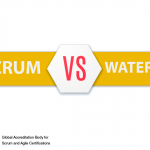One of the most common adopted agile approaches in industry today is SCRUM, more so for agile software development. In order to adopt the approach, core principles of SCRUM have to be implemented. Various organizations have implemented agile approach including SCRUM.
Ten keys that help a company identify changes that have to be implemented for SCRUM to meet its needs.
1. Assess its Suitability
SCRUM is an incremental method which enables a higher level workflow at the team level. Agile software development has SCRUM as one of the approaches. Scrum at its core has sprints, daily meetings and the product backlog maintains work items. Scrum Master, product owner and the development team are the three roles in SCRUM. Also for the product and process it includes continuous enhancement feedback loops. However scrum is not a good fit for organizational and product software development
The primary key for SCRUM adaptation is to determine the methodology is ideal for the project or various other projects in the company.
2. Adhere to Core Principles.
The most critical part of SCRUM is to understand the core principals and adopt them. The major cause for failure of a project is not adhering to the core principals of SCRUM.
The outcome of this varies from project cancellation to building the system from scratch. This leads to the project being delayed, to the over budget and various other issues which affects the user needs.
3. Tailoring needs for SCRUM adoption.
Playing by the book SCRUM can be a good fit for few projects; few companies tailor the methodology to meet their needs. However it’s important to play by the book at initial stages of the project so that the fundamentals are understood & approach adopted. Also it’s absolutely necessary to stick to the core SCRUM principles.
4. SCRUM Roles
Scrum master, Product owner, and development team are the three major roles for SCRUM. When adopting SCRUM for a project it’s important to understand the implications of implementing these roles.
Scrum Master– one who facilitates the scrum process and the team also ensures that the process is being followed, enable cooperation between team members, help in decision making.
Also he has to take care of outside interference and remove barriers.
Product owner– He defines the features of a product, or organizes the features of a product according to the business value. He works closely with the development team.
Development Team- Determines the set of work that needs to be completed. After completion of each sprint, a demo of the product is shown to the product owner.
5. Collaboration.
For SCRUM to be successfully adopted there has to be an emergence of a self empowered team. In order to make sure this is done a team must be made up of indivuials from all disciplines required to define, build, validate, and prepare the software for release.
6. A balanced perspective.
During the adoption of SCRUM, it’s important to determine the long term visibility for a team in direction of the project. The long term visibility into the expected functionality of the project is provided in the product backlog in most of the cases. In order to promote a constant understanding of the project a near, mid and long term goal has to be adopted.
7. The Essentials.
A supporting essential infrastructure is required for a high quality product to be delivered. As a team plans to work to finish each Sprint, they have to maintain the required infrastructure and practices for product development
This includes a solid build and a test frame work, creating and automatically executing unit tests, validating ongoing daily or continuous builds and developing the guidelines that need to be followed by the team
This reduces risk, validates the quality of the product and also enhances the productivity of the team.
The maintenance of an essential infrastructure should start from the first Sprint and continue for the duration of product development.
8. Supervise the Architecture.
The principle of SCRUM is that the requirements, planning and design emerge throughout the project. However without supervising the project a company can end up with two undesirable results.
One a team can over engineer in a particular Sprint building up an infrastructure and system that’s never required,
Two a team can spend very little time designing a Sprint and later realise the fundamentals are too weak to support the objective of the project.
It’s essential that while adopting scrum a company has to ensure that couple of indivuials from the team guide the architecture of the product as it is developed.
9. Multiple aspects of a product.
While adopting scrum one common mistake that a company usually commits is, designing a product solely based on the end user value they provide. This doesn’t provide a complete perspective of all the work necessary to release a product that will meet the end user’s requirements and comply with all the company constraints.
To make sure the product does both the below three aspects are recommended.
- The customer value has to be defined. This should include the functionality, non functionality requirements such as how scalable, robust and fast it has to be.
- The technical value of building a new infrastructure for software development has to be defined.
The business value for the entire product development has to be defined.
10. In the end, purpose of adopting Scrum.
When a company is thinking about deploying a customized version of Scrum, the methodology will not meet the requirements in the first Sprint of the project. It’s necessary that the company deploys short Sprints in the starting of the project and learn from the experience and make necessary changes where ever required.
Few common areas that need to be refined during adoption of scrum is
- Change in the definition of done once the Sprint is over.
- Modifications in how a team works during the Sprint
- The team composition has to change
- Scrum Methodology supported by additional software development. Processes and practices.
- Constant refinements to balance between change and long term visibility.









